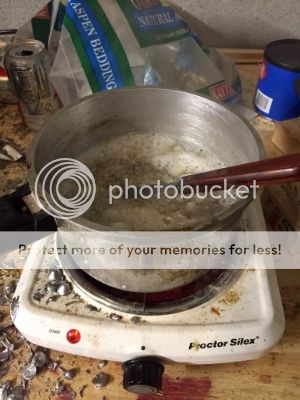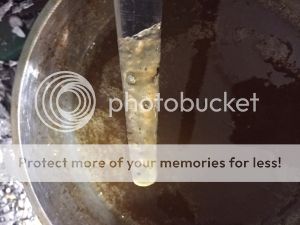Many of the lubes Ian and I have made involve the use of a reasonable percentage of Ivory soap. This makes the lube making process a bit more involved but not difficult, you just need to understand what is happening.
This batch was made with castor oil, Ester 100 AC oil, micro wax, vaseline, 90wt gear oil, beeswax, ivory soap, and for the first time some cetyl ester.
The beeswax doesn't take the heat the way the rest of the stuff can so it and the cetyl ester were added last after removing the lube from the heat.
These lubes need lots of heat and be sure to use a pan larger than you think is needed, they foam up a bit when cooking.

This is the ingredients as they begin to heat. This is all but the cetyl ester and beeswax.

As the stuff heats and melts it will begin to foam.

As you can see the foam builds up quite a bit, this is why the pot needs to be larger than you think. The foaming can be reduced a bit by adding the soap after the rest of the stuff has melted and in small increments. I no longer do that as I have made enough to know what to expect. Stirring a bunch does help keep the foam under control.

The foaming has subsided and now the heating really takes off. This stuff needs to reach about 450 degrees F to fully melt so don't splash it on your skin, it burns like hell. Stirring often is needed at this point. I also use the spatula to break up the bits of soap to help them melt faster. The finer the soap particles the faster they melt.

Here the soap is completely melted and mixed in. Take it off the heat at this point.

I let it cool with stirring until it begins to gel. This is the point where I add the beeswax and cetyl ester. Lots of stirring to get them melted and mixed in quickly.

I then pout into a foil pan and let it cool. I don't mess with them until the next day. These lubes seem to like to rest overnite before you get a good idea of how they feel.
These lubes are nice in that they leave little residue on the gun. They also are not prone to melting in high temp shooting situations. They are not a lube you can melt and pour into a sizer easily, they need lots of heat the really flow that readily.
This batch was made with castor oil, Ester 100 AC oil, micro wax, vaseline, 90wt gear oil, beeswax, ivory soap, and for the first time some cetyl ester.
The beeswax doesn't take the heat the way the rest of the stuff can so it and the cetyl ester were added last after removing the lube from the heat.
These lubes need lots of heat and be sure to use a pan larger than you think is needed, they foam up a bit when cooking.

This is the ingredients as they begin to heat. This is all but the cetyl ester and beeswax.

As the stuff heats and melts it will begin to foam.

As you can see the foam builds up quite a bit, this is why the pot needs to be larger than you think. The foaming can be reduced a bit by adding the soap after the rest of the stuff has melted and in small increments. I no longer do that as I have made enough to know what to expect. Stirring a bunch does help keep the foam under control.

The foaming has subsided and now the heating really takes off. This stuff needs to reach about 450 degrees F to fully melt so don't splash it on your skin, it burns like hell. Stirring often is needed at this point. I also use the spatula to break up the bits of soap to help them melt faster. The finer the soap particles the faster they melt.

Here the soap is completely melted and mixed in. Take it off the heat at this point.

I let it cool with stirring until it begins to gel. This is the point where I add the beeswax and cetyl ester. Lots of stirring to get them melted and mixed in quickly.

I then pout into a foil pan and let it cool. I don't mess with them until the next day. These lubes seem to like to rest overnite before you get a good idea of how they feel.
These lubes are nice in that they leave little residue on the gun. They also are not prone to melting in high temp shooting situations. They are not a lube you can melt and pour into a sizer easily, they need lots of heat the really flow that readily.
